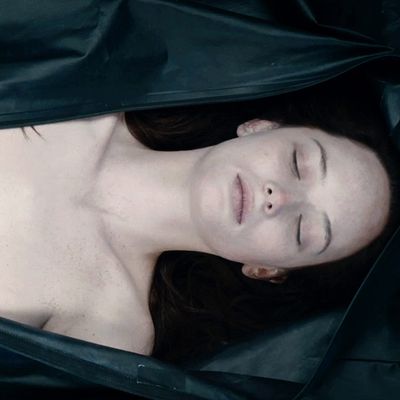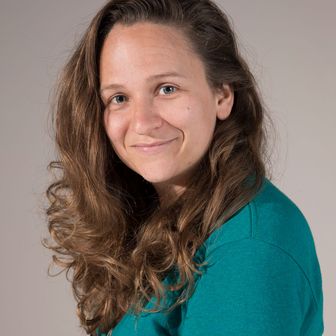
Over the Christmas holiday, moviegoers had a fabulous charcuterie board of big-budget cineplex staples and toned-down, poignant character studies to choose from. But if you preferred in-home entertainment, there was also the Stateside release of The Autopsy of Jane Doe, the third feature from Norwegian director Andre Øvredal (Trollhunter), and one of the best horror movies of 2016. Jane Doe follows a father and son team of coroners (Brian Cox and Emile Hirsch) tasked with completing an autopsy for local law enforcement: A naked woman has been found half buried in the basement of a house where a handful of grisly murders were committed, and the cops need answers ASAP. But as the two men get deeper into the case, and into the body, their subterranean medical work space becomes a chamber of terrors, and cutting further into the corpse on the table is their only means of figuring out why.
The most fascinating part about Jane Doe, though, isn’t how Øvredal scares you. (Which, to be sure, he will.) It’s how he turns the titular character’s lifeless figure into an essential screen presence, and how he manages to frame an entire film around the dissection of a woman’s naked body without it being disturbing in the wrong way.
Horror is, obviously, a problematic genre for women. Yes, they’re frequently the sole survivors of slasher films, but as victims their bodies are violated and exploited exponentially more than their male counterparts. This makes Øvredal’s sensitive and even beautiful presentation of actress Olwen Catherine Kelly’s form even more impressive. The more Hirsch and Cox’s characters cut into Jane Doe’s body, the more they seem to be punished, but Øvredal takes extreme care to make sure they never retaliate against her flesh for the terror she seems to be catalyzing. The camera doesn’t linger too long, and it doesn’t voyeuristically detail the curves of her silhouette. Despite being naked, Kelly is not a fetish object; she is a character in a story with complex history to unearth. In a great year for horror heroines, Øvredal managed to create one of the best without even so much as showing her blink.
In a conversation with Vulture, Øvredal emphasized that shooting Jane’s body “gracefully” was one of his primary goals for the film. “There are all kinds of movies that have female corpses, and I saw a lot of things I didn’t want to do,” he said. “I wanted to make sure Jane Doe is the hero of the movie — to respect her physically, make sure that she wasn’t sexualized. I tried to constantly shoot her in ways that were clinical.” It was a tough line to walk: At times, he said, he ended up getting shots that crossed the line, “where you could just feel the shape of her body more.” Those got left on the cutting-room floor.
Horror is a genre of violation. The characters onscreen, and by proxy the viewers, are meant to feel threatened and uncomfortable. If you’re not, the movie isn’t doing its job. What Øvredal shows us, though, is that examination need not mean exploitation; by presenting body horror in an effective, yet sensitive way, he provides the payoff of both freaking his audience out and finding humanity in a character that would be easy to treat as a prop. Horror is our pop art at its most brutal, and many movies in the genre flourish in the service of cheap thrills. But on a higher level, they also provide opportunities to dissect our most basic impulses. How do we treat each other, and how do we treat those around us who are most vulnerable?
You can’t get much more vulnerable than having a naked lady splayed out on a table with men standing over her holding sharp knives; it would take meticulous attention to detail to prevent Jane Doe from becoming fodder for a leering gaze. It’s not objectification to notice that Kelly, the actress who plays Jane, is striking. Her beauty makes the viewer feel more invited to look, which makes the trick of hiding her body more challenging. Horror fans likes to watch, so to speak, but it’s the director who tells them where to look.
“The subject of sex has a tendency to come up in most of these movies,” said Øvreda. “I wanted to make sure that the style we filmed it in was equally respectful. She comes in like a body or an object — they are just supposed to work on her. But as the movie progresses, the important part of it is to identify with her, and to make her a human being, somebody you care about. She has been through something horrible, and I wanted to let that affect the characters in an interesting, emotional way.”
Though he hails from progressive Scandinavia, the Norwegian Øvredal is a self-described “American-phile” who studied filmmaking at the Brooks Institute in Santa Barbara, California, and says he prefers the “clean, simple structure” and “more focused narratives” of American movies. In Jane Doe, the combination of his passion and heritage melds to form the kind of direct, quickly paced horror we gravitate toward here in the States, but with an egalitarian point of view and an elegantly Scandinavian type of restraint. “I’m definitely deliberate about making sure that female characters are portrayed in an equal way, and not sexualized or done for silliness,” the director says. “It’s so boring to watch movies that do that. It’s so unsophisticated.”
Many of last year’s best horror films featured dynamic female leads, and told stories centered on mothers and daughters, criminals and cannibals and witches — women who were often dirty, complicated, dark, selfish, and unsavory. The genre has a long way to go in terms of diversity, but at the very least, horror has a new benchmark for how to effectively write women: If you can’t make your heroines at least as interesting as the one who’s lying naked for 90 minutes in Jane Doe, you should probably start over. “I always want to make sure women are portrayed in as equal light as anybody,” says Øvredal. “It’s just, why not? There’s no reason not to.”


